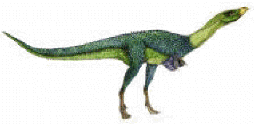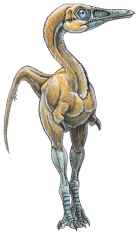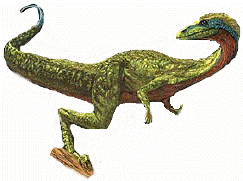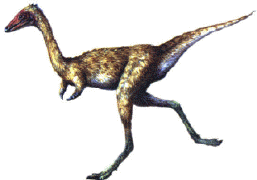|

|
|
Alvarezsauridae |
|
|
Alvarezsaurus calvoi
was discovered in Argentina in 1991. It was a small, lightly-built, bird-like, bipedal theropod. The
incomplete fossil skeleton revealed that it was unique in that it had
a single large claw on each of its forelimbs. It was discovered and
described by José Bonaparte as the anchor taxon of a new family, the
Alvarezsauridae
and its containing taxon (clade), Alvarezsauria. This first species
was loosely classified as a ceratosaurian. It was named for the historian Don
Gregorio Alvarez, not the more familiar physicist Luis Alvarez,
who proposed that the Cretaceous-Tertiary extinction event was caused
by an impact event.
Actually it was not the first of these strange dinosaurs to
be discovered. In 1923, a partial skeleton of a strange dinosaur was
found in the Gobi Desert, but there was not enough material to get a
good idea of its appearance. A group of scientists reexamined it and
found that it was also an Alvarezsaurid. The fossil remains were more
complete than Alvarezsaurus calvoi, so they helped to fill out the
picture of what these animals looked like. They named it
Mononykus olecranus.
In 1987 a joint
Soviet-Mongolian expedition found a few remains of a bipedal dinosaur.
It was similar to Velociraptor, who lived at the same time and
was also found in the Gobi Desert. This
newly discovered dinosaur appeared to be related, but
was much smaller - about the size of a turkey. In 1992, an
expedition team from the American Museum of Natural History and the
Mongolian Academy of Sciences discovered more fossilized remains of this
fossil, which they named Shuvuuia deserti . It had a
single claw on each forelimb established that it was also an
Alvarezsaurid. More important was the discovery of two complete
skulls. Although Shuvuuia looked like
a dinosaur, examination of the skulls showed that it had a pointed
beak filled with tiny teeth. The most amazing thing is that it could raise its upper jaw, with respect to the braincase.
This is a characteristic of modern birds. The group was reclassified
as flightless birds.
The subsequent discoveries of
Patagonykus puertai and Parvicursor remotus provided even more
information.
Novas & Pol (2002) and other authors consider them a gorup of
non-conforming theropods. The Alvarezsaurids are now considered to
belong to a group of dinosaurs known as the Maniraptorids ,
which includes Deinonychosaurs, Therizinosaurs and Oviraptorids, as
well as true birds, which are now considered to be specialized flying
dinosaurs.
While its exact position is uncertain, Alvarezsauridae is placed
just a step or two away from Archaeopteryx. Alvarezsaurid
material has also been reassigned to Ornithomimus, and there
may be a relationship between the alvarezsaurids and the
Ornithomimosauria. Classification is
difficult because the known specimens are all very derived forms from
the late Cretaceous, which provides little information on what early
forms they evolved from.
All five species had very similar skeletons. All had long
legs, suggesting they were fast runners. All also had long tails
and many bird-like features in the backbone, pelvis and hindlimbs. In
fact, Mononykus looked even more birdlike than Archaeopteryx. On the
other side of the coin, The
Shuvuuia deserti skulls show that
it was more closely related to modern birds than is the famous first bird, Archaeopteryx.
Plus their forelimbs were short and stubby. Shuvuuias forelimbs were
much like that of an ostrich and emu. They were very strong, but
certainly unsuitable for flight.
The primary distinguishing characteristics of these dinosaurs is
that they were believed to have had but one big claw on each of their
forelimbs. This is different from all other theropods as they have
three. New evidence has shown that Alvarezsaurids probably never
lost the two other fingers, but they had shrunk to almost nothing.
They did vary in size.
Parvicursor remotus is now the smallest known dinosaur. It was a
little smaller than a chicken.
Patagonykus puertai was the largest. At six feet in length, it was
close in size to its contemporary,
Velociraptor. It is possible that
Rapator ornitholestoides and
Heptasteornis andrewsi (see above) could be members of this
family. If so, then Alvarezsaurids could have been over 20 feet in
length. Unfortunately the fossil records of these species is so scant
that no classification is possible.
Although these animals are extremely bird-like, no fossilized
feathers have been found. If it had feathers, then they were not
preserved.
Mary Schweitzer has made an important study of the "dino fuzz" fossilized
integument found with
Shuvuuia desertit and arrived to the conclusion that the main
chemical component is Beta-Keratin: Important demonstration that "dino
fuzz" is in reality feathers. |
|
|
|
|
|
|
|
|
Edugraphics.Net | Feenixx Publishing |
|
|
|
|
|
![]()



